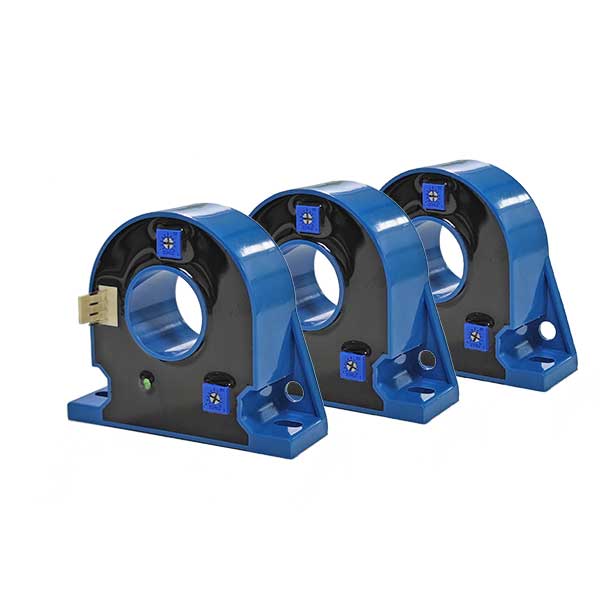
Tabla de contenido
En el campo de la ingeniería eléctrica, comprender el flujo de corriente es fundamental. Ya sea para controlar el consumo de energía, proteger circuitos o controlar maquinaria, la medición precisa de la corriente es crucial.
Aquí es donde un transductor de corriente Entra en juego el concepto de transductores eléctricos, que actúa como herramienta indispensable para convertir corrientes eléctricas en señales mensurables. Para quienes se inician en este campo, adentrarse en el mundo de los transductores eléctricos puede resultar abrumador. Sin embargo, con un conocimiento básico de sus principios y aplicaciones, se puede transitar por este terreno con confianza.
¿Qué son los transductores de corriente?
En esencia, un transductor de corriente es un dispositivo que convierte una corriente eléctrica en una señal de salida proporcional. Esta señal de salida puede ser en forma de voltaje, corriente o frecuencia, según el diseño del transductor. Al utilizar diversas técnicas de detección, los transductores de corriente proporcionan mediciones precisas de la corriente sin necesidad de interrumpir el circuito que se está monitoreando.
Tipos de transductores de corriente
Los transductores de corriente vienen en varios tipos, cada uno adaptado a aplicaciones y principios operativos específicos:
Transductores de efecto Hall
Estos transductores funcionan según el efecto Hall, en el que un campo magnético perpendicular a la dirección del flujo de corriente induce un voltaje perpendicular tanto a la corriente como al campo magnético. Este voltaje, conocido como voltaje Hall, es proporcional a la corriente que se mide.
Transductores de bobina Rogowski
Las bobinas de Rogowski son bobinas flexibles con núcleo de aire que envuelven el conductor por el que circula la corriente que se desea medir. Cuando la corriente varía, se induce un voltaje en la bobina, que luego se integra para obtener una señal proporcional a la corriente.
Transformadores de corriente (TC)
Los transformadores de corriente son quizás el tipo más común de transductores de corriente. Constan de un devanado primario por el que fluye la corriente que se va a medir y un devanado secundario conectado al instrumento de medición. La relación de espiras entre el devanado primario y el secundario determina la corriente de salida.
Transductores de resistencia de derivación
Las resistencias en derivación se colocan en serie con la carga o el circuito que se está midiendo. La caída de tensión en la resistencia es proporcional a la corriente que fluye a través de ella, lo que permite la medición de la corriente.
Estos sensores son fiables y sensibles y pueden medir unos pocos miliamperios de corriente continua. Suelen utilizarse para monitorizar baterías.
Sensor de corriente de la serie HIT de Hangzhi – Son de bajo costo como los sensores de corriente de efecto Hall, pero tienen un rendimiento mucho mejor. En comparación con la precisión 1% del sensor de corriente de efecto Hall, los sensores de corriente HIT tienen las siguientes ventajas: precisión de 0,05%, linealidad de 50 ppm, desplazamiento cero inferior a ±10 uA.
La instalación no intrusiva de un transductor de corriente fluxgate de núcleo dividido es una de sus principales ventajas. No es necesario interrumpir el circuito simplemente fijando el dispositivo alrededor del conductor, lo que lo convierte en una alternativa viable para monitorear sistemas existentes sin generar tiempo de inactividad.
Transductores de corriente de núcleo dividido de la serie CIT de Hangzhi basado en el tecnología de puerta de flujo Con una precisión de 0,05%, estos sensores pueden realizar mediciones aisladas de corriente continua y corriente alterna.
Aplicaciones de los transductores de corriente
Los transductores de corriente encuentran aplicaciones en diversas industrias y campos, entre ellos:
Monitoreo de energía
En los sistemas eléctricos, el control de la corriente es fundamental para mantener la estabilidad del sistema, evitar sobrecargas y optimizar el uso de la energía. Los transductores de corriente desempeñan un papel fundamental en el control del consumo de energía y en garantizar un funcionamiento eficiente.
Control de motor
En entornos industriales, el control preciso de los motores es esencial para optimizar el rendimiento y garantizar la seguridad. Los transductores de corriente proporcionan información en tiempo real sobre las corrientes del motor, lo que permite un control preciso y protección contra condiciones de sobrecorriente.
Detección y protección de fallos
Los transductores de corriente son componentes integrales de los relés de protección que se utilizan para detectar fallas como cortocircuitos y sobrecargas. Al monitorear los niveles de corriente, estos dispositivos pueden activar medidas de protección para aislar las secciones defectuosas de un sistema y evitar daños.
Gestión de la energía
En los sistemas de energía renovable y las aplicaciones de redes inteligentes, los transductores de corriente facilitan el control y la gestión del flujo de energía. Al medir con precisión las corrientes en paneles solares, turbinas eólicas y sistemas de baterías, estos dispositivos ayudan a optimizar la producción y distribución de energía.
Consideraciones a tener en cuenta al elegir un transductor de corriente
Al seleccionar un transductor de corriente para una aplicación específica, se deben considerar varios factores:
Comprenda los requisitos de su aplicación
Antes de seleccionar un transductor, debe saber para qué lo necesita, como el tipo de corriente (CA o CC), el rango de valores de corriente que necesita medir y la precisión requerida.
Considere el rango de medición correcto
Los sensores de corriente tienen un rango de corriente determinado y pueden medir con gran precisión. Este rango se denomina rango de medición. Es fundamental elegir sensores con un rango de medición. Si el rango es demasiado alto, existe el riesgo de sobrecarga del sensor, mientras que si el rango es demasiado bajo, no se puede medir todo el rango de corriente. La resolución del sensor o el cambio mínimo de corriente que puede detectar también es crucial.
Preocuparse por la precisión y linealidad del sensor
La precisión y la linealidad son consideraciones igualmente importantes para el transductor. La precisión es la precisión con la que sus lecturas coinciden con los valores reales, mientras que la linealidad de un sensor es su capacidad de mantener una sensibilidad constante en todo su rango de medición. Para garantizar lecturas precisas y confiables, se debe utilizar un sensor con buena precisión y linealidad.
Los transductores de alta precisión deben tener tasas de error bajas y brindar lecturas consistentes y confiables. Los productos de sensores de corriente industriales Hangzhi IIT tienen alta precisión, linealidad y estabilidad, y características de deriva de baja temperatura y deriva cero, y brindan servicios a nuestros clientes con el mejor rendimiento y un costo efectivo.
Considere el tiempo de respuesta
El tiempo de respuesta se refiere al tiempo que necesita un sensor para registrar los cambios en la corriente y generar las señales de salida adecuadas. La selección de un sensor con un tiempo de reacción rápido garantiza lecturas precisas y oportunas. Si el tiempo de reacción es demasiado largo, el sensor o el circuito pueden resultar dañados en situaciones en las que la corriente cambia constantemente.
Evaluar el tipo de señal de salida
Verifique el tipo de señal que envía el transductor de corriente. Los tipos de salida típicos incluyen señales digitales y señales analógicas (corriente o voltaje). Verifique que la señal de salida del transductor sea compatible con su sistema de control o dispositivo de adquisición de datos.
Condiciones ambientales, montaje e instalación
Tenga en cuenta el entorno operativo, incluido el rango de temperatura, la humedad y la posible exposición a productos químicos o vibraciones, y elija un transductor que pueda soportar estas condiciones.
Asegúrese de que los requisitos de montaje e instalación del transductor se ajusten a las capacidades y limitaciones de su sistema. El aislamiento también es uno de los factores a tener en cuenta a la hora de elegir sensores. Asegúrese de que el transductor proporcione un aislamiento eléctrico adecuado para la seguridad y para evitar interferencias de la señal.
Comprobar compatibilidad con sistemas existentes
Verifique la compatibilidad del transductor de corriente con sus sistemas existentes. Asegúrese de que el tamaño físico, las opciones de montaje y las conexiones eléctricas del transductor se adapten perfectamente a su configuración.
La compatibilidad reduce la necesidad de realizar modificaciones adicionales y garantiza una integración sin problemas. Verifique que el transductor cumpla con los estándares y especificaciones requeridos para su sistema.
Cumplimiento, normas y costes
Compruebe que el transductor cumpla con las normas y regulaciones industriales pertinentes para su aplicación. Considere el costo del transductor en relación con su presupuesto y el valor que ofrece en términos de rendimiento y confiabilidad.
Verifique la reputación del fabricante
Antes de comprar un transductor de corriente, averigüe qué tan conocida es la empresa que lo fabricó. Lea reseñas y pida recomendaciones a profesionales del sector. Elija un transductor de un fabricante de confianza con un buen servicio de atención al cliente y un historial confiable.
Conclusión
Comprender los principios y aplicaciones de transductores de corriente Es fundamental para los ingenieros y técnicos que trabajan en campos donde la medición de corriente eléctrica es fundamental. Con la información proporcionada en esta guía, los principiantes pueden emprender su viaje hacia el mundo de los transductores de corriente con confianza, conociendo los conceptos y consideraciones fundamentales involucrados.
